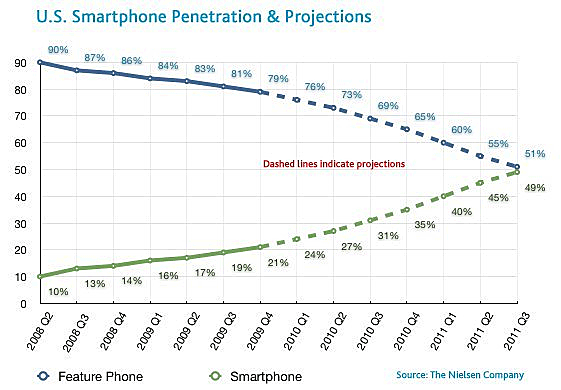This is the first in a multi-part series of articles exploring various tools and tactics for promoting and marketing on the mobile web.
From museums and opera companies using QR Codes to festivals using Foursquare to launch a musical scavenger hunt, it's becoming apparent that designing a mobile marketing campaign can be one of the more challenging, creative and rewarding ways to engage customers.
Consider some of these recent findings:
- A Nielsen Company report recently indicated that U.S. smartphone penetration will be over 50% in 2011.
- Diana Pouliot – Director of Mobile Advertising at Google – revealed that one-third of all Google searches via the mobile web pertain to some aspect of the searcher’s local environment
- Mobile campaigns are capturing an increasing level of consumers' attention across key metrics: mobile ad awareness reached 31% in 2010, up from 14% in 2009 and 16% in 2008.
US Smartphone Penetration Graph
Smartphone Use On the Rise!


As smartphones increase in popularity, users are often utilizing this technology to discover local events and local businesses that may interest them. This has resulted in an increased demand for businesses wanting to implement effective mobile marketing campaigns. In this blog series, I want to examine what tools and strategies arts organizations can use to implement effective campaigns.
Location Based Tools
One of the most popular uses for smartphones is generating directions to and/or information about local businesses. Here are two tools that organizations can use to elevate their visibility to smartphone users.
1. Google Places:
With the recent launch of a Google Places App for both the iPhone and Android platforms as well as a scheduled Google Maps update for the Android smartphone, the importance of having an up-to-date listing in Google Places is extremely relevant for an effective mobile marketing campaign. Below is a screenshot of the Google Places app in action:

Google Places Iphone App
To ensure that your organization appears in a Google Places mobile search, you must first make sure that you register with Google Places online. Here's a quick overview of how to get started
- Claim your business by verifying your listing
- Add pictures and videos to make your Place Page more compelling
- Review the Google Places Getting Started Guide for any other questions
- Bonus Tip: If your organization receives a certain amount of positive reviews, Google will mail a window decal with a personalized QR Code. 200,000 businesses have already received these decals.
- Bonus Tip #2: An easy way to boost your rankings in a Google Places Search is to make sure your business is properly listed in online directories like Yellow Pages and City Search. Google indexes these "citations" in order to determine what is most appropriate to a user's search query
Google Places QR Code
- Bonus Tip #3: According to a recent article on Mashable.com, Google Hotpot - recommendation engine and ratings/reviews system for places - has "officially gone worldwide." Hotpot integrates with Google Places and also appears in Google search results. Here's a brief overview of how Hotpot works:
2. Yelp Another popular app for smartphones is the local search platform, Yelp. The company has reported that more than 41 million people visited Yelp within the past 30 days (as of December 2010). Yelp also reports that 27% of its searches come from its iPhone application. Businesses can setup free accounts to post pictures, special offers and send out messages to customers.
Yelp Apps
Just like Google Places, businesses owners must first register their organization on Yelp's website. Login to Yelp for Business Owners in order to create a listing for your business. One of the major challenges with maintaining a Yelp and Google Places profile is encouraging patrons to leave positive reviews. The easiest way to receive reviews, is simply to ask for them.
In upcoming posts, we will be examine: effective 'check-in' campaigns on services like FourSquare and Gowalla, how to set up QR codes, developing mobile applications, and how to run effective short code (SMS) campaigns.









